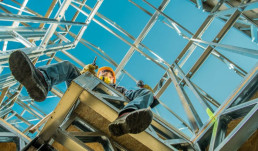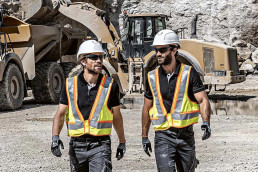Occupational health and safety on building sites is crucial. If this is neglected, there is a risk of serious accidents. Although the number of notifiable occupational accidents has fallen in the construction industry, the number of fatal accidents on building sites has increased. But what do you need to be aware of when it comes to building site safety? In this blog post, we explain the rules and regulations for occupational health and safety on building sites and tell you everything you need to know to avoid potential hazards on your building site.
Potential hazards on building sites
A large number of factors must be taken into account when it comes to eliminating potential hazards on a building site. This is due to parallel work processes and a dependency on a working environment that is constantly changing with regard to soil stability and weather conditions. Yet inadequate safety and protection precautions, for example due to deadline pressures, are avoidable causes of hazardous situations. Amongst other things, falling objects and objects lying around, heavy loads or work with corrosive substances or electrical current pose an increased risk of injury.
Conscientious implementation of building site safety measures is particularly important for work at height. That is because people falling count among the most frequent potential hazards, alongside unsafe excavations and negligent handling of electrical current. According to the Head of BG Bau’s Department for Prevention, falls during work at height almost always result in serious injuries with dramatic consequences for the persons concerned and, when falls from large heights are involved, often end in death. “Yet these incidents can be avoided through compliance with a few simple rules.” Whilst fall restraint systems prevent people from reaching a fall hazard, fall arrest systems ensure people or materials can be brought to a safe stop if they do fall. In general, the fall protection system is defined as a “necessarily effective device, which stops the fall of a falling worker even without their conscious involvement and protects against a further fall”. Catchment devices, fall guards and side protection panels can be used here.

Due to the difficult working conditions, electric current is also one of the most frequent causes of accidents on building sites. If electrical machinery and equipment is damaged, repaired incorrectly, put under excessive strain, used improperly or contaminated, it forms the basis for a multitude of safety risks.
Safety-technical requirements, which aim to minimise the risk of accidents, include having a trained electrician check that the electrical system is in perfect condition. The safe function of the machinery used must also be checked at the beginning of each working day, and only machinery and equipment that is certified to meet the requirements and can withstand the weather conditions on the building site must be chosen.
BG Bau risk assessments
The BG Bau risk assessment is a crucial basis for compliance with and supplementation of measures for the occupational health and safety of workers.
By detecting defects and safety gaps in good time, it is possible to integrate protective measures against many safety risks on the building site. This is of particular importance for small and medium-sized enterprises in the construction industry where machine downtimes and staff absences can have a very negative impact on the productivity level and quality of work as well as the company’s success.
It is no wonder then that the German Occupational Safety and Health Act (Arbeitsschutzgesetz) stipulates a risk assessment of working conditions and activities.
In addition, existing workflows can be improved through the assessment of risks and loads, and the introduction of counteractive measures.
Rules for occupational health and safety on building sites
In principle, the Rules on Occupational Safety and Health on Construction Sites (RAB) serve to provide information on the current state of safety precautions on building sites and to minimise the risk of accidents on building sites.
These specific occupational safety regulations are defined by the Committee for Safety and Health Protection on Construction Sites (ASGB). More detailed information on the contents of the occupational health and safety ordinances, in particular on building sites, is listed in the respective sections of the RAB.
For example, RAB 33 refers to the fact that, during the planning and execution phase of construction activities, the general principles of Section 4 of the German Occupational Safety and Health Act (Arbeitsschutzgesetz, Regeln zum Arbeitsschutz auf BaustellenArbSchG) must be taken into account by the client and by the health and safety coordinator. Although responsibility lies with the individual employees, it must be ensured that these principles of the German Occupational Safety and Health Act are applied and adhered to during implementation of their work.

Construction Site Ordinance
The German Construction Site Ordinance stipulates specific statutory regulations on building site safety and accident prevention. This serves to ensure that occupational safety is taken into account from planning to coordination on the building site. To guarantee safe collaboration on the building site, the expertise of a health and safety protection coordinator is often required. Their core skills lie in consulting with the client and using their expertise to clarify questions about construction processes and working methods. On the other hand, the health and safety coordinator is responsible for communication between the client and the tradespeople employed on the building site.
By developing a so-called health and safety plan (Sicherheits- und Gesundheitsschutzplan, SiGePlan), the coordinator ensures a smooth and effective workflow for the construction work.
The SiGePlan is used as a basis for determining trade-specific and cross-trade risks and avoiding them during the execution phase. The health and safety coordinator therefore plays a significant role in significantly reducing the hazard potential on the building site. To do this, the coordinator organises the spatial and time-related assignment of activities, informs all those involved about assigned measures for safe working in the context of the occupational safety requirements and gives additional further recommendations for the work to be carried out.
Protective work clothing for greater safety
Suitable protective work clothing, in compliance with the safety standards, is another step towards risk avoidance on building sites. No construction worker should recklessly forego protective equipment.

Because a helmet isn’t worn just to comply with defined safety rules, but to protect the fragile head during everyday work and in an emergency in the event of an accident. That’s why the occupational health and safety requirements must be observed not only under supervision or as required, but throughout the entire duration of work on the building site. This will significantly reduce the risk of a serious accident at work. It doesn’t matter whether we’re talking about safety shoes with protective toe caps or chemical-resistant safety spectacles, uvex offers a wide range of clothing and personal protective equipment for the construction industry. We’re happy to advise you in detail on your choice of protective clothing for your work sector.
Have you heard of our safety clothing for the construction industry? Read our blog to find out all about the sturdy uvex 3 – the premium model for the construction industry. The blog also contains interesting facts about the subject of construction noise and which rules and rights you have on the building site.